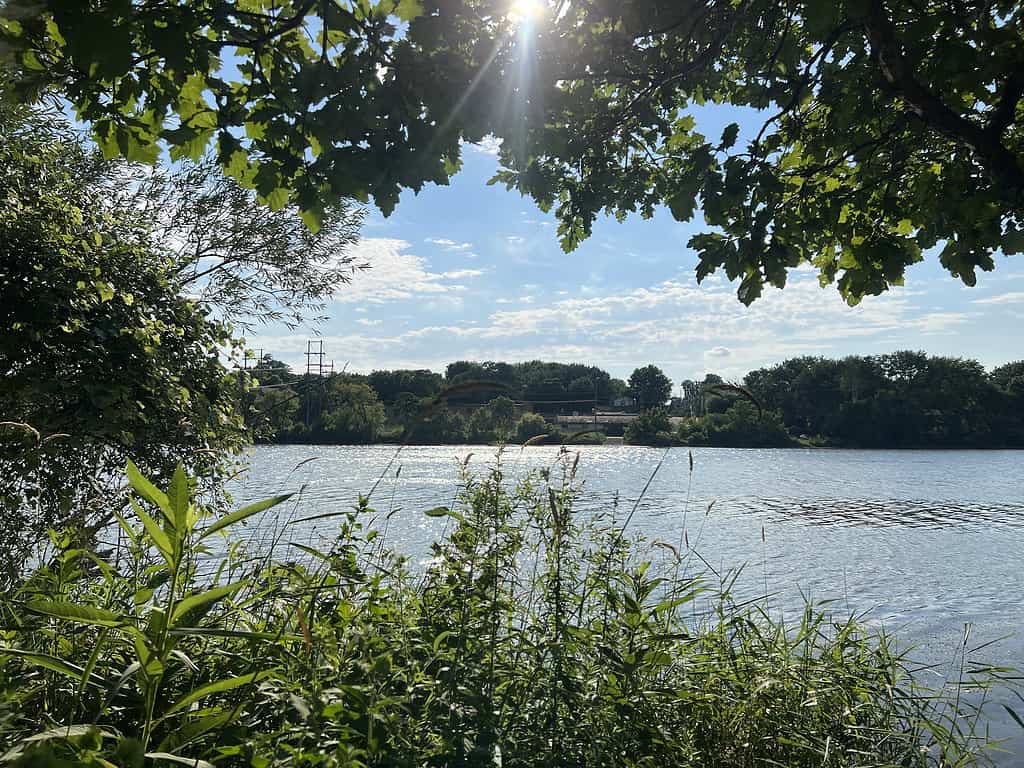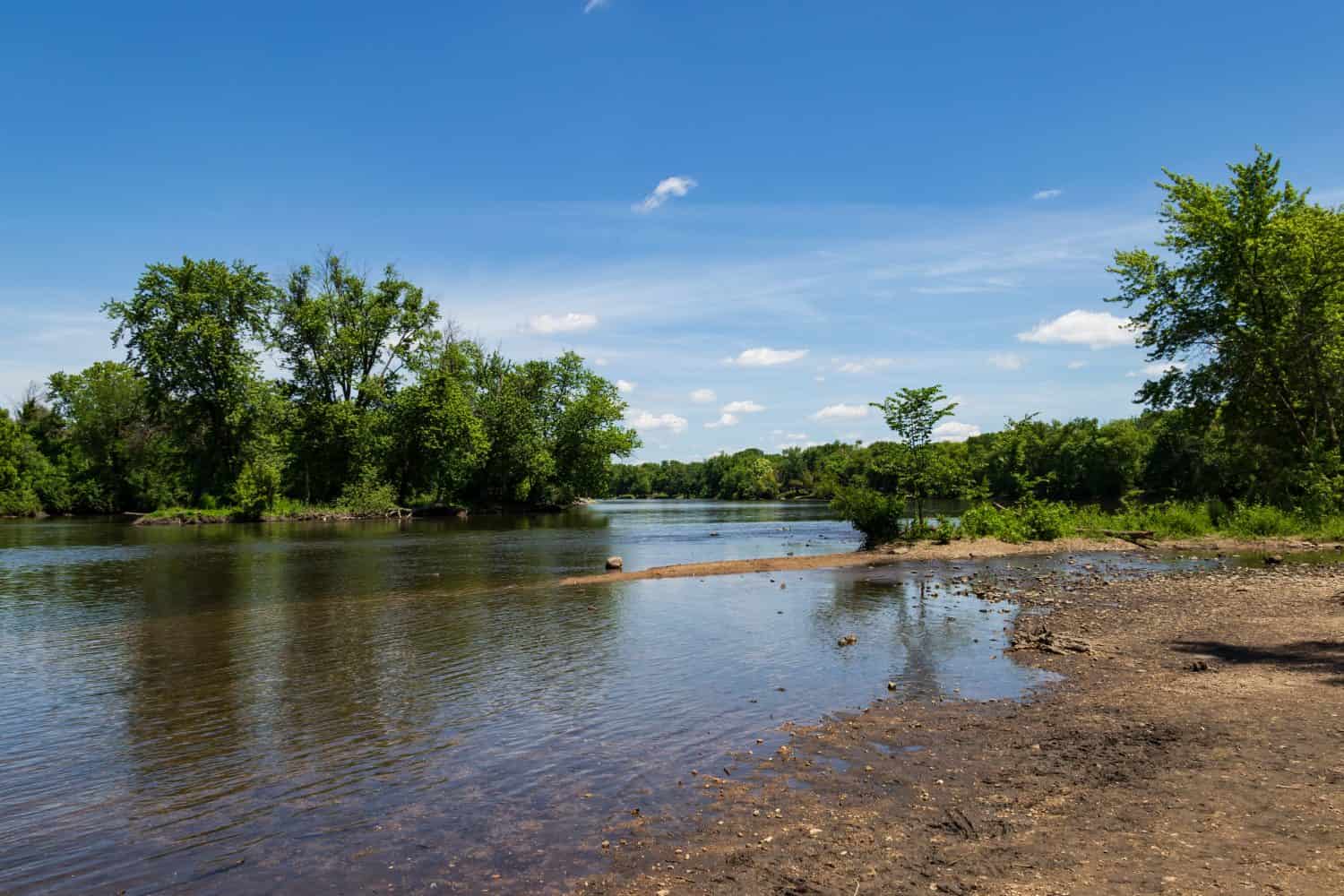Today, we’ll be looking at a river that flows through the Midwestern states of Wisconsin and Illinois. According to the Wisconsin Department of Natural Resources, Wisconsin is home to more than 12,600 rivers and streams. Illinois only has a total of 317 rivers. Let’s look at a river that factors in to both sets of numbers – the Fox River. The Fox River is a 223-mile tributary of the Illinois River, and it flows through both states on its journey. We’re going to find the deepest points of the Fox River, and we’ll explore some more information about the river as we do, including looking at its course and learning what kind of wildlife the river hosts. So, how deep is the Fox River? Let’s find out.
How Deep is the Fox River?

The Fox River flows through Wisconsin and Illinois and reaches a maximum depth of about 24 feet.
©Jeronimo Podesta/iStock via Getty Images
The average depth of the Fox River is only about 4-5 feet. However, there are some spots that drop much deeper than this. According to a document released by the University of Wisconsin Green Bay, the Fox River reaches a maximum depth of 24 feet. This is uncommon for a glacial stream, as many rivers and lakes formed by glaciers reach depths much more extensive than the shallow river we see here. Of course, the waters used to be much deeper when the river originated, and a series of factors including dams, climate change, and water usage have impacted the depth and flow of the river.
Where Does the Fox River Start and End?

Silver Springs State Park in Illinois is just one beautiful area that the Fox River flows through.
©Brian Kapp/Shutterstock.com
The Fox River begins in Wisconsin in a place called the Halbach Swamp. This location is about 15 miles northwest of Milwaukee, near the community of Colgate, Wisconsin. The river continues from its headwaters and flows past several Wisconsin towns, including Brookfield, Big Bend, Waterford, Wheatland, and Wilmot. The section of the Fox River that exists in Wisconsin is about 84 miles long.
As the Fox River leaves Wisconsin and enters Illinois, it encounters a series of interconnected lakes – the Chain O’ Lakes. From here, the river continues another 118 miles to its mouth at Ottawa. The mouth of the Fox River is at its confluence with the Illinois River. There are several communities and towns in Illinois that rest by or rely on the Fox River, including Fox Lake, McHenry, Cary, Fox River Grove, Algonquin, Carpentersville, Elgin, and Oswego. About one million people live in the Fox Valley, a valley in Illinois that relies on the Fox River.
Wildlife in the Fox River
This river is famous in the area for sport fishing and runs rich with bass, catfish, bluegill, walleye, and muskies. Other animals, such as skunks, white-tailed deer, raccoons, beavers, and Canada geese, can be found near its waters. Mallard ducks and bald eagles have also been commonly seen along the entire length of the river.
Some other animals that you might see along the Fox River are sandhill cranes, spotted sandpipers, red-winged blackbirds, and stiff tickseeds. The Fox River National Wildlife Refuge is home to dozens of species of birds and draws bird and wildlife watchers from far and wide to wonder at the diversity of fauna and flora in the area.
Some Fox River History

A view of the river today likely cannot encapsulate the way it looked when it was a wild and important river – before European Settlement.
©Andy Wilcock/Shutterstock.com
The Fox River has been an important resource for human and animal life for thousands of years. The Fox River watershed covers 2,658 square miles on its course from Colgate, Wisconsin, to Ottawa, Illinois. The historic lands it shapes and flows through were once home to several indigenous tribes who relied on the waters of the river. Rivers and the riparian areas that surround them are often home to a larger diversity of animal species. Ancient tribes in the area found this to be true in both Wisconsin and Minnesota and used the Fox River and its surrounding areas as prime hunting grounds during the 1400s, 1500s, 1600s, and 1700s.
This time was during the day of the bison, and the Fox River Valley was full of them. Perhaps this is why the first-known name of the Fox River was actually “Pestekouy”, or “bison” in the Algonquin language. The rolling prairies that surrounded the river were an ideal place for bison, and the natives – perhaps unwittingly – preserved this area by burning the prairies in the fall. This protected the prairies and encouraged new growth while keeping invasive trees at bay. This area – and the river that made it so important – was not just important for its food sources.
The French and the Fox River
When the French arrived in northern Illinois in the 1600s, they immediately recognized the area as a fantastic trade area and hunting grounds. They put their full attention on the area for over 100 years, and this led to disaster. French hide hunters realized just how many bison were in the area by the early 1700s and sought to capitalize on this “hide supply”. Between 1702 and 1704, they had killed and skilled over 12,000 bison with the intention of shipping their hides back to France. This event signaled the end of most of the bison population in Illinois. This was the beginning of the end for bison in the state all together, and the large mammal had almost completely disappeared from Illinois by the 19th Century.
With bison out of the picture, the French lost interest in the area. Map of the area during the era of eradication left the Fox River unnamed. Battles and skirmishes between the French and the Fox Indians threatened the lands and the people in it. Soon, it would be time for the native peoples of the area to be driven out and killed the way the bison were. The area would slowly move toward supporting colonists and the river would end up dammed in 15 places to support a new and growing world. Today, the landscape of the Fox River is vastly different than it was when it flowed wild and free through the land of the bison.
The photo featured at the top of this post is © Andy Wilcock/Shutterstock.com
Thank you for reading! Have some feedback for us? Contact the AZ Animals editorial team.






